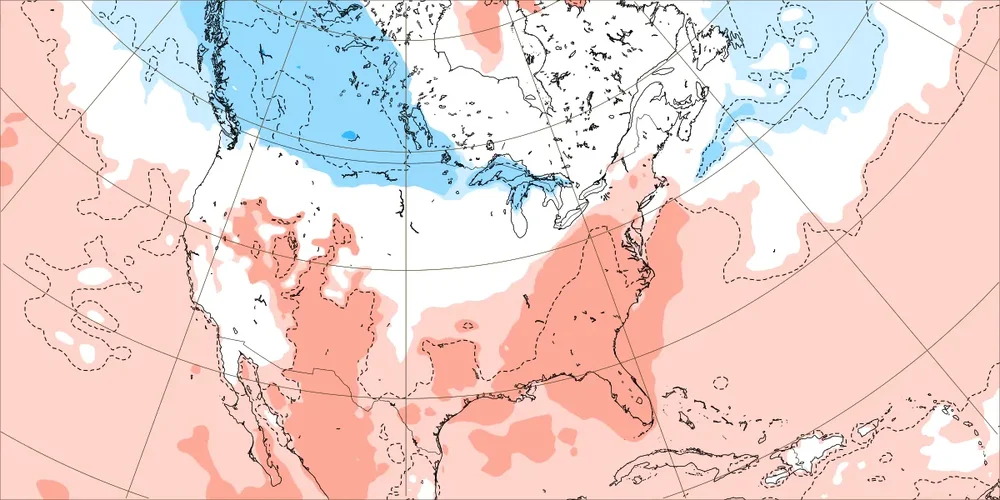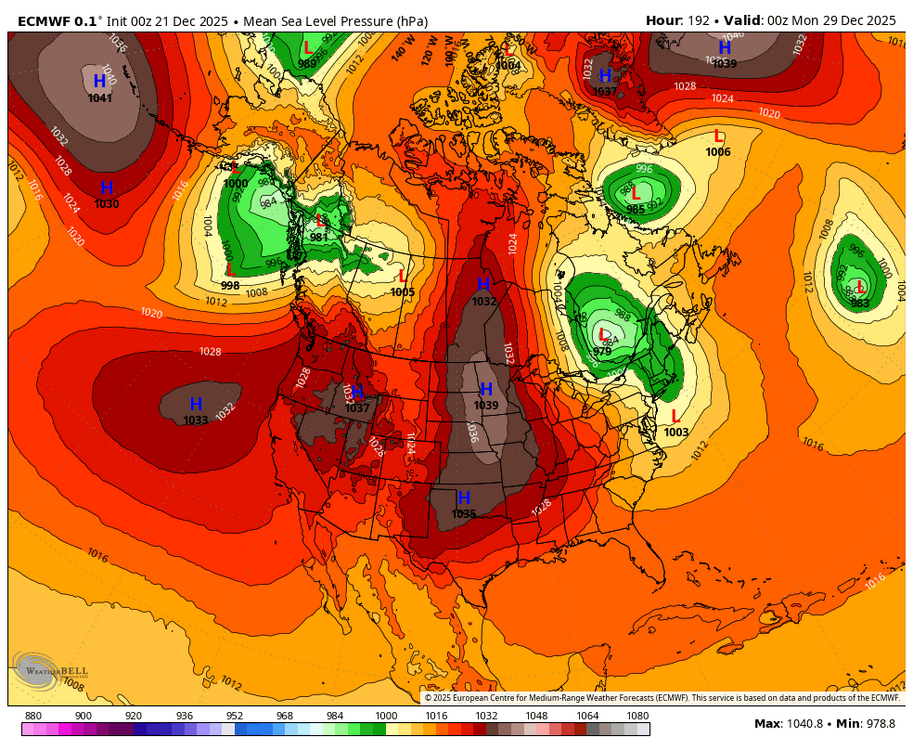
GaWx
Members-
Posts
17,703 -
Joined
Content Type
Profiles
Blogs
Forums
American Weather
Media Demo
Store
Gallery
Everything posted by GaWx
-
I continue to have a concern about certain WxBell maps being off. I’ve discussed the CFS being wacky and mainly too cold a number of times with@donsutherland1. But I also can’t figure out why their Euro Weekly (EW) maps are always colder than the ECMWF’s own EW maps! To me it just tells me that the WB EW maps are significantly too cold, period, which remains a concern. Why are they too cold? It’s definitely not due to climo base differences because if anything the in-house uses warmer climo (last 20 years), not colder, vs WB’s 1991-2020. Warmer climo means colder in-house anomaly maps, the opposite of reality! So, that makes the discrepancy even worse! Here’s examples from today’s EWs: 1. For Jan 12-18th: ECMWF: AN ~80%, BN ~2% of US WxBell: why do they have… - AN in only ~1/3 of US vs 80% on in-house? - BN ~25% of US vs only 2% on in-house? ————- 2. For Jan 19th-25th: ECMWF: AN ~50%, BN ~ 3% of US WxBell: why do they have… - AN in only ~15% of US vs 50% on in-house? - BN ~50% of US vs only 3% on in-house?
-
MJO is in day 3 (12/17-19) of the 3rd phase 8 of this month:
-
The models are pretty unanimous on continuing the -WPO into Jan and the strongly -WPOs in Dec strongly support a -WPO as we know. We also know that the -ENSO -PNA stats since 1983-4 suggest good support for a +PNA Jan. But both the Euro Weeklies and extended GEFS continue to show a -PNA throughout Jan (see images below). Are you saying these models are totally wrong and will correct toward +PNA? If so, why do you think they’re going -PNA? Persistence? (even though I’ve seen the EW predict PNA changes and do well).
-
Today, I asked Eric to address his earlier thoughts about Feb having good prospects to go against the grain of warm Niña Febs should La Niña fade early. He implied that, regardless, we’re not doing enough. I then asked him, “What do you mean that we’re not doing enough? How’s ENSO looking to you for Feb?” His answer: I would like to see a big and slow MJO event to go across the entire Warm Pool in January and I am not seeing that. These Convectively Kelvin Waves are moving us towards El Nino of course, but the westerly wind bursts from them aren’t as strong or sustained as I’d like them to be to zonally advect the warm pool eastward more quickly. Our only ticket out of this crap mid to late winter is to push the warm pool east enough to extend the pacific jet to a point where we get a +PNA/+TNH/+NAO pattern instead of a -PNA/+TNH/+NAO. That seems less likely to me than say a month or so ago given how the Warm Pool has behaved to this point @40/70 Benchmark
-
FFC is forecasting 4 days of 70s highs in ATL: 12/24-7 with 12/28 in the mid 60s. As has been said, the 4 days of 70+ in late Dec would be pretty historic although not as high as a few years that had 5-6 days of 70+ in late Dec.
-
Looking at strong -WPO Decembers since 1950 verifies your statement for a -ENSO that’s in Dec and continues through JF per RONI. I count 10 strong -WPO Decembers during -ENSO winters. Here’s how the subsequent WPO ended up for JF averaged out: 2013-14: -WPO 2010-11: -WPO 2005-6: +WPO 1995-6: -WPO 1983-4: neutral WPO 1964-5: neutral WPO 1962-3: -WPO 1961-2: -WPO 1956-7: -WPO 1955-6: -WPO So, the tally for the JF avg is 7 -WPO, 2 neutral WPO, and 1 +WPO. So, these 10 strong -WPO Decembers during -ENSO decently favored -WPO for the average of JF fwiw. Both are favored to be -WPO but Jan is the most strongly favored for that. Out of these 10, 7 Jans had BN temps in the SE. The ones that didn’t were 1965 (NN), 2006 (AN), and 1957 (AN). But Feb leaned AN, which isn’t surprising with -ENSO.
-
Indeed, the warmest Euro Weeklies run so far this season is still yesterday’s as todays is slightly less warm during several weeks in the E US overall. So, slightly better than yesterday but still ugly overall for cold lovers in the E US overall. It doesn’t look as good as two runs ago that were all NN to slightly BN throughout the E US 1/12-2/1. Todays for that period is mainly AN in most of the E US for that 3 week period. Consistent with that, today’s doesn’t show signs of a building +PNA in the means like the run from 2 days ago showed. A year ago at this time the EW were quite cold for much of Jan, which got me so excited and verified very well. As always when it’s warm, I’ll continue to hope it busts badly.
-
You can relax now. The 12Z Euro has no storm, which was fully expected due to the 0Z coming out of nowhere in semi-fantasyland and with hardly any EPS support. But the 12Z does look solid cold as early as the PM of 12/29 and lasting through 12/31 fwiw. However, its E US trough is stronger than other 12Z ops and is thus currently an outlier for the cold. Regardless, the colder trend seems to be there. So, we’ll see. Edit: The 12Z EPS has no support for a synoptic scale SE snowstorm as they support a mainly dry shot of cold.
-
Indeed, this combo has been a rarity in at least Dec. Looking at history for Dec, I looked to see the last time there was a strong -WPO dominating with a neutral or +EPO. It looks per the current December’s numbers that there will end up a strong -WPO while there will probably be a weak +EPO average (with the 3 +EPO periods averaging longer than the 3 -EPO periods). The last half month+ long period within Decs when there was anything similar was the first half of 1995 (extreme -WPO and weak +EPO), the first half of 1966 (very strong -EPO and neutral EPO), and Dec 7-23, 1956 (extreme -WPO and moderate +EPO). Over a shorter timeframe, Dec 1-10 of 2012 had a very strong -WPO while there was a moderate +EPO.
-
The roads from this highly unlikely 0Z Euro still in semi-fantasyland (mainly Dec 30th there) snow out of nowhere (and only one of the 50 EPS members (#30) has anything like this) would be fine by Jan 2nd per the same run. So, you’d just be left with beautiful scenery for your closing. If this were to somehow happen though, there’d be many very upset members NC/TN north. They’d be giving @suzookand @dsaura hard time! So, maybe it’s better it not happen lol. I don’t think they’ll need to worry about this occuring.
-
Don’t look at the 0Z Euro….or better yet look at it OMG! Many NC peeps won’t be thrilled but anyway: this is for 12/30 to early 12/31:
-
-
As I said, a year ago at this time the NOAA weeks 3-4 maps were quite cold looking (strongest cold signal in SE quadrant on record since this product started being issued) and they obviously verified quite well (although to be fair these aren’t actually forecasts): OTOH, 4 years ago at this time (when many E US posters’ tones on the wx boards were similarly gloomy) they were similarly mild looking to yesterday’s for much of the E US, which turned out to be “wrong”:
-
They’re still called Weeklies because that is based on their own extended maps being for one week at a time, not based on their release frequency. Today’s Euro Weeklies run/extended EPS mean was the warmest run yet this season for the E US overall. Today’s extended GEFS doesn’t look much better for the E US its entire run if you prefer cold (like I do). But obviously I’m hopeful they will bust badly! A year ago at this time, they were cold for the E US and NOAA’s weeks 3-4 products were about the coldest on record for the SE US. I was posting a lot about those outlooks as well as the cold Weeklies and was very excited. What a difference a year makes! They often have a decent clue as to the general upcoming pattern. But not always. So, we’ll see.
-
Today was another nice day for a walk here! Mid to low 60s, sunshine, a light breeze, and dewpoints in the 40s. Due largely to the great walking wx, I’ve taken walks every day since Nov 29th per my phone’s fitness ap. According to it over the last 10 years, I’ve never taken anywhere near that many days in a row of walks! Usually something (wx or other) gets in the way at least once a week.
-
And not surprisingly, Dec/Jan 1917-18 was (one of) the coldest in E US on record!
-
Today’s Euro Weeklies weeks all trended warmer than yesterday and AN for most of the US. No trending toward a +PNA mid-Jan like yesterday. Yesterday’s had NN in SE 1/12-2/1. One of the worst runs this season and hopefully coming days will reverse.
-
December 2025 Short/Medium Range Forecast Thread
GaWx replied to John1122's topic in Tennessee Valley
Today’s Euro Weeklies weeks all trended warmer than yesterday and AN for most of the US. No trending toward a +PNA mid-Jan like yesterday. Yesterday’s had NN in SE 1/12-2/1. One of the worst runs this season and hopefully coming days will reverse. -
The good news is that highest on any 12Z model for Christmas in your area is only 65-68 and some are cooler. These are quite a bit lower than the 74ish record highs. ATL, otoh, may be pretty close to its 75 record.
-
Nationally, 12/25/25 is going to be close to the historically warm 12/25/21.
-
It will be historically warm but 2021 was close.
-
December 2025 Short/Medium Range Forecast Thread
GaWx replied to John1122's topic in Tennessee Valley
22, 96, 84 -
The GEFS and EPS have big disagreement 12/25-1/3! Fwiw, JMA, BOM, and CFS favor GEFS: Meanwhile, phase 8 , which helped bring strong cold Dec 3-7 and Dec 15 but won’t next week, returned on 12/17 and will likely be with us for awhile:
-
I loved the 3 week cold stretch! I’m still enjoying the cool/dry of yesterday and this weekend. Great for walking! Was down to mid 30s this AM. The impressive torch is progged to be most concentrated during 12/23-8 (and much of that period will still be pleasant with pretty low dewpoints) and with any later torchy days up in the air since good model skill doesn’t go out that far. Despite the warmup Charlotte will still likely end up NN for Dec. ATL likely slightly AN. RDU/GSO likely slightly BN.
-
December 2025 Short/Medium Range Forecast Thread
GaWx replied to John1122's topic in Tennessee Valley
Strong SPV during cold and snow Nashville since 79: -Jans of 25, 22, 16, 00, 96, 84…so, 6 of 14 cold and snowy Jans had strong SPV (00 cold/snow last half of Jan) -Feb of 96 Strong Jan SPV has been progged by Euro Weeklies, which have and usually do well:








